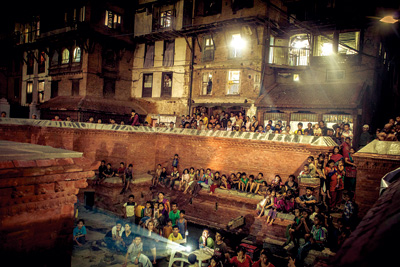With a focus on creating dialogue, various institutions tie up to organize a three-day event focused on bringing art and culture to the public spaces of Kathmandu.
Interactive Mapping and Archive Project (IMAP) recently concluded its three-day celebration of art and culture in the valley with a line-up of music, street art and performances. IMAP, a project initiated by the Social Science Baha, receives funding from the Ford Foundation to create archives of cultural institutions and independent artists. Through the project, different activities and events are held each year, including Artist in the City. “We actually began working on the concept in 2010 but the first time it took place was last year,” explains Promina Shrestha, the Programme Officer for the project. Organized as an annual event, the program aims to promote its goal of initiating dialogues on social transformation within public spaces in Kathmandu with the help of the arts.
 Artists and institutions are chosen based on their application, and eventually profiled and archived on IMAP’s webpage. “We are always looking to put forth a culturally diverse group of participants,” Shrestha says, adding, “This year we had jazz and cultural dance groups and classical and contemporary music. There were also fusion acts as the students of tradition delved into the modern,” recounts Shrestha. Besides music and theatre, another area of focus for IMAP is art. Following up on last year’s success, IMAP chose Sattya Media Arts Collective of Jawalakhel as their art delegates. “Sattya’s proposal was different from what the happened last year; it was interactive and got people involved in the process,” Shrestha said on their decision to select the collective.
Artists and institutions are chosen based on their application, and eventually profiled and archived on IMAP’s webpage. “We are always looking to put forth a culturally diverse group of participants,” Shrestha says, adding, “This year we had jazz and cultural dance groups and classical and contemporary music. There were also fusion acts as the students of tradition delved into the modern,” recounts Shrestha. Besides music and theatre, another area of focus for IMAP is art. Following up on last year’s success, IMAP chose Sattya Media Arts Collective of Jawalakhel as their art delegates. “Sattya’s proposal was different from what the happened last year; it was interactive and got people involved in the process,” Shrestha said on their decision to select the collective.
While the first day was concluded at the Patan Museum, the remaining two days were supervised by Sattya at Hanuman Dhoka. Working with the space selected by IMAP in the Maru Hiti area of the Durbar, the collective prepped a decrepit wall where a vegetable market usually settles in the evening. Before the beginning of the program a lonely turquoise-green wall stood overlooking a busy alley, with white letterings spread across. It read “start where you stand” in Nepali. By the end of the day the wall was covered in more than 60 portraits of local residents whose pictures bore possible personal endeavors that could help curb a local issue.
The “Start Where You Stand” campaign was first worked out in Pokhara during the collective’s rural run. The Maru Hiti wall is the third such installation of its kind. Anya Vaverko, Founder-Director of the collective believes the inspiration lies behind the fact that the installation “brings the problems of a city and a country, or a community, or the world, down to a manageable size. It emphasizes on the idea that all of us have the capacity to bring about change in our lives and to our world.” The campaign also hits home for Sattya’s do-it-yourself take on issues, which they have cultivated in their other endeavors.
The combination of visuals, rhetoric and critical thinking worked well to attract the attention of concerned citizens, excited children and many passersby. Even those who didn’t make it to the event now have a wall covered in proclamation of good will and proper conduct to distract them from their commutes; a wall of ideas that could inspire more people to think critically, towards a common good. ■










